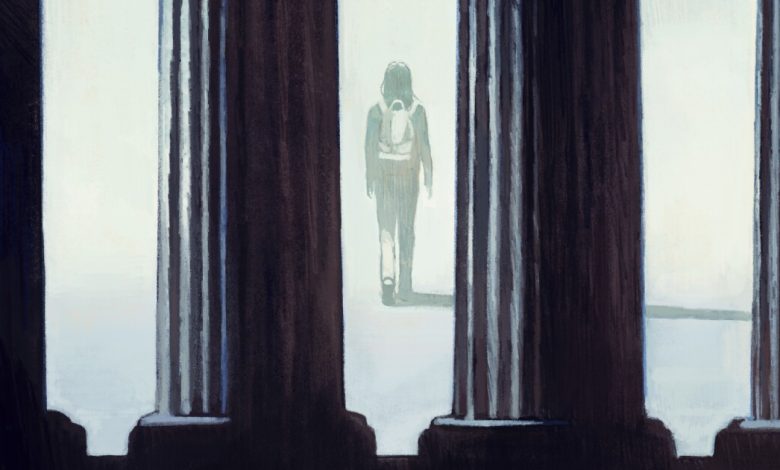When College Students in Crisis Ask for Help, Will They Be Kicked Off Campus? Depends on the College.

Days earlier, Reimer had been discharged from the psychiatric ward at Dartmouth-Hitchcock Medical Center, where she was under supervision after a suicide attempt. Her friends had noticed self-destructive behaviors in Reimer before. She would post on social media about drinking too much or make offhand comments about “wanting to lose control.” But on the night that Reimer said she had swallowed hundreds of pills in an attempt to overdose, her roommate, Caroline Kramer, knew that her friend’s thoughts of self-harm had taken a more serious turn.
As she recovered in the hospital, Reimer insisted that, above all, she wanted to remain on campus. The college determined that she could return to her classes after her six-day stay in the psychiatric ward, but now with a prescription for antidepressants and a therapist from the college whom she would speak to regularly.
“She was happy she had been given medication,” Kramer says. “She was glad to be back, and it was good that she now had a counselor.”
To support her recovery upon her return to campus, Reimer agreed to keep her friends and counselor apprised of any thoughts of self-harm. So days after coming back, when she began to feel overwhelmed by the work she had missed, she let her friends on campus and at home know that she was still struggling with suicidal thoughts. Her friends from home called campus security officers, who arrived to find that Reimer had calmed down after Kramer helped her get in touch with Dartmouth’s counselor on call.
Reimer insisted that she did not need to return to the hospital. The officers left after receiving assurance that her situation had stabilized.
What happened next, according to Kramer and an anonymous post on a campus forum that Kramer confirmed was by Reimer, was not what Reimer expected. Later that night, campus security officers returned with orders from the college. Reimer would need to be rehospitalized, they said. Despite her insistence that she felt safe and didn’t want to be recommitted, she was checked back into the psychiatric ward.
From there, the dispute quickly escalated. Reimer asked to be discharged and allowed to continue her spring term from campus. The college refused: She was to be placed on a mandated medical leave. Not permitted back into her dorm room, she asked her mother to collect her belongings and left for her home, in Holtsville, N.Y.
Kramer says contact with her roommate grew spotty from then on. Meanwhile, in the post on the campus forum, Reimer vented her frustration with how Dartmouth officials had handled her case.

Courtesy of Marco Rincon
“I told them numerous times that being sent home would be the worst thing for my mental health,” she wrote.
Back in her childhood bedroom, some 200 miles away from her friends and the support network she had built on campus, Reimer’s hope of continuing her Dartmouth career as normal faded. Family members told The Valley News that on May 19, just over a month after she was made to leave campus, Reimer received an email from a dean stating that she would not be able to drop her first-year seminar to retake later if she wished to advance to her sophomore year in the fall.
Around an hour later, alone at home, she died by suicide.
After Reimer’s death — the third suicide in Dartmouth’s freshman class that academic year — students responded with an outpouring of grief mixed with anger at what they saw as another failure by college administrators to properly address the mental-health crisis on campus. “For the love of God, do anything,”read one column in the student newspaper. Among other demands for improved mental-health services on campus, the columnist pleaded for a review of the college’s involuntary-medical-leave policies: “Stop punishing students for suffering.”
The thorny debate over the proper use of mandated medical leave — or if a proper use exists at all — long predates Reimer’s case. Victor Schwartz, a psychiatrist and former college dean, spent eight years as medical director of the Jed Foundation, a suicide-prevention organization, advising colleges on how to handle students who might pose a threat to their own or others’ safety. He says that when making decisions to place students on medical leave involuntarily, college administrators find themselves torn between maintaining the students’ rights to determine their own care and protecting the campus community from disruptions.
“There aren’t obvious good guys and bad guys in most of these stories,” Schwartz says.
Colleges with involuntary-medical-leave policies maintain that it is sometimes necessary to remove students who are harming themselves or are at risk of self-harm, even if their behavior doesn’t threaten others, so the students can concentrate on receiving the care they need.
Dartmouth would not comment on Reimer’s circumstances specifically. But Diana Lawrence, the college’s associate vice president for communications, explained its policy in an email: “Students who are on a medical leave do not live on campus because it is in their best interest to put their studies on hold and focus on their recovery.”
There are no national figures on how many college students have been removed from their campuses following a mental-health emergency, nor on how many students say that such a removal affected them adversely. What can be observed more concretely, though, are the vast inconsistencies in college policies for handling such emergencies.
A Chronicle review of policies at the 100 colleges ranked highest by U.S. News & World Report revealed that they are almost evenly split on whether they include a provision for involuntary medical withdrawal. That lack of consensus among these colleges, which tend to have more resources to devote to mental-health care and are more frequently the subject of landmark disability-rights litigation, highlights the deep-seated nature of disagreements about how best to help students in crisis.
Out of that sample, 54 colleges have policies for removing students from the campus involuntarily for medical reasons. Of the other 46, 23 provide a medical-leave process that can be initiated only voluntarily, and 22 do not outline leave processes specifically for medical reasons. The remaining college, Boston University, dedicates one sentence to involuntary medical leave in its regular medical-leave policy, but it has no established policy beyond that.
Among the colleges with mandatory-leave policies, how is a student’s capacity to remain on campus assessed? What accommodations of the student’s needs are reasonable? Can the student appeal the decision? And what are the criteria for readmission? There is little agreement on the answers to those questions.
A student in crisis at one college might be paired with a college-employed case manager, who would then work to ensure that the student got treatment on campus. Another student, like Elizabeth Reimer, might be left without an advocate to coordinate her care during the critical post-hospitalization period, when people with suicidal behaviors are at their highest risk of relapsing.
“My sense is that students’ stories are very, very diverse,” says Miriam Heyman, a senior researcher at the Lurie Institute for Disability Policy who has studied involuntary-medical-withdrawal protocols at prestigious colleges. “You’ll find some students who found school professionals who worked with them with the utmost flexibility and patience … and some students who had the exact opposite experience.”
The moral and practical questions of how best to help a student are complex, to be sure, and were so even before the pandemic upended students’ lives and placed greater demands on colleges’ mental-health services. But the very nature of the policy terrain — uneven and unsettled — can have life or death consequences.
With unclear or missing guidelines, students may fear retaliation for expressing thoughts of self-harm — a deterrent to even mentioning the onset of a crisis. The absence of an appeals process might leave students feeling slighted or abandoned once they have been removed from campus, and cumbersome re-entry standards could harm students who feel otherwise ready to return to their communities. Amid this landscape of inconsistent policies, colleges must contend individually with the burdens and liabilities that arise from arbitrating when a student’s condition demands care beyond what they can provide.
“Most of the time, students don’t want to go home — they want to stay in school,” Morris says. And so the college works to help them do so.
Morris, whose research has focused on models for college students to recover in place following a mental-health emergency, agrees with many mental-health experts across the country: Involuntary medical leave should be a last resort, after all other reasonable options have been exhausted.
Cases of involuntary medical leave tend to be less common than voluntary ones. According to Lawrence, Dartmouth’s associate vice president for communications, an average of 55 students each year take psychiatric-related medical leaves, and Reimer’s case was the college’s sole instance of mandated medical leave in the past six years. In fact, few, if any, colleges continue to impose involuntary medical leave as an immediate response to suicidality. To do so would run afoul of the Americans With Disabilities Act — a federal law that the U.S. Department of Education’s Office for Civil Rights has determined to mean students with mental illnesses are entitled to the same processes for receiving accommodations as are students with physical disabilities.
But The Chronicle’s review shows that colleges’ medical-withdrawal policies and their applications vary in nearly every other aspect. Even on matters on which the Office for Civil Rights, or OCR, has handed down clear guidance — namely, that students under consideration for involuntary withdrawal are first entitled to reasonable accommodations and an individualized assessment — college policies diverge.
Of the 54 colleges with involuntary medical leave as a written policy, only about two-thirds explicitly note that the college will exhaust all reasonable accommodations for students before opting to withdraw them. Out of this group, only seven colleges name specific accommodations — including course-load reductions, pass/fail grading, and changes in housing — that they would be willing to consider first.
A slightly larger share of colleges — 42 of the 54 with involuntary-medical-withdrawal policies — outline detailed procedures for assessing students on a case-by-case basis. For the remainder, though, processes for evaluating a student’s need for a medical leave remain opaque.
For example, at Syracuse University, the policy for on-campus dance parties is nearly seven times as long as the student handbook’s 71-word paragraph on mandatory medical leave.
Students exhibiting signs of suicidality at Syracuse would not be likely to know whether their behavior constitutes “misconduct that has its basis in a psychological or medical condition,” the university’s standard for consideration of a mandated leave. Rather than reassure students seeking help that they can do so without fear of retribution, Syracuse’s brief policy raises more questions than it answers. The university did not respond to several emails and a call seeking comment for this article.
Experts say that clearly written policies for medical leave are crucial to ensuring that students feel safe engaging with their college’s mental-health services in the first place.

Hokyoung Kim for The Chronicle
“What’s written matters, because what’s written is what empowers students to advocate for themselves,” says Heyman, the Lurie Institute researcher, who wrote a 2018 paper evaluating the shortcomings of medical-leave policies at Ivy League colleges. Using a grading system based on adherence to OCR guidance and psychiatric expertise, Heyman found that none of the eight institutions earned higher than a D, though she notes that some of their policies have been modified slightly since the paper’s publication. At the time, two colleges, Dartmouth and Yale University, received an F.
In The Chronicle’s sample group, some policies contain language casting suicidal thoughts or acts of self-harm as immature or a potential cause for punishment by the university.
“Students are considered adults when attending the university, and students have a responsibility to not cause harm to themselves or others and to participate in university life safely,” begins the policy for involuntary medical withdrawal at both Florida State University and the University of Florida, where Morris works. At the University of San Diego, a “suicidal attempt, gesture, or statement of suicidal attempt” falls into the category of “disruptive or dangerous behavior,” which can trigger the college’s involuntary-withdrawal process alongside disciplinary action.
By contrast, policies like Brown University’s openly encourage students to notify the college if they begin to experience suicidal thoughts, and to take a medical leave proactively. (Brown has only a voluntary medical-withdrawal policy.) In a university-run blog called “Medical Leaves of Absence Demystified,” Brown deans acknowledge that taking time away from college might sound stressful to some students, and they provide reflections from students and parents to underscore the benefits of taking a medical leave for mental-health purposes.
Amid this landscape of incongruent policies, some mental-health experts worry that college administrators have been saddled with making health-care decisions for which they are not equipped.
“These aren’t written with student mental health at the forefront,” Heyman says. “They’re based on administrative and bureaucratic concerns on the part of the university.”
The practice of placing students on leave for posing a risk to themselves, not necessarily to others, continues to be one of the most contentious aspects of involuntary-medical-withdrawal policies. Around two-thirds of the colleges that offered involuntary medical leave in The Chronicle’s sample specifically said that presenting a threat to oneself would trigger an assessment for withdrawal.
However, Nance Roy, the Jed Foundation’s chief clinical officer, bristles at the notion that colleges remove suicidal students from their campuses to protect the institution’s image — or its purse.
“What unfortunately gets reported is, ‘Oh, the school doesn’t want liability if someone dies by suicide,’” Roy says. “And I can tell you that I’ve never heard that from a school.”
The self-harm debate illustrates the disjointed way that policy change often occurs in the realm of campus mental health. In 2010, OCR announced that it had revised its definition of what a “direct threat” to campus could look like, in light of the Americans With Disabilities Act. No longer would threats to self be included. The new wording referred only to individuals who posed “a direct threat to the health or safety of others.”
The wording change left the National Association of College and University Attorneys, which provides legal advice to higher-education lawyers, baffled. The group’s lawyers asked OCR for further clarification. In particular, they sought federal guidance that would respond to the “realities that institutions of higher education are not residential in-patient treatment facilities and that some students cannot safely stay on campus.”
A decade later, federal standards remain foggy. Instead, lawyers have turned to OCR’s responses to individual complaints for hints as to how to they might deal with suicidal or at-risk students. The association has since interpreted such OCR decisions to mean that colleges can still remove students on the basis of exhibiting self-harmful behaviors, as long as colleges apply an equivalent medical-withdrawal standard for students with other disabilities.
The result is policy change that occurs in increments, rather than systematically. News coverage of cases at elite colleges, in particular, tends to attract attention, and therefore action.
“Typically what happens is there’ll then be an article somewhere about students’ being strong-armed out of school and forced to leave, which then results in a sort of shifting of the dial again,” says Schwartz, the former medical director of the Jed Foundation.
Recent examples of landmark settlements dealing with involuntary medical withdrawals include a 2019 class action against Stanford University, which agreed to consider involuntary leave only as a last resort and to first seek appropriate accommodations for students returning from hospitalization. In 2016 the U.S. Department of Justice reached a similar agreement with Princeton University, requiring it to spell out the types of accommodations a student could first receive. And a settlement with Brown University last August required it to pay more than $600,000 in damages to students who had been denied readmission after a medical leave, alongside clarifying its readmission policies.
Brit Vanneman, a legal fellow at the Bazelon Center for Mental Health Law, similarly describes policy change as a localized process, confined to the ebbs and flows of public attention and litigation against specific colleges.
In recent years, Vanneman says, she has noticed a jump in complaints against colleges related to involuntary medical leave that have been submitted to the Bazelon Center’s lawyers. The center attributes that rise in part to students and families growing more aware of their rights, alongside the Department of Justice lately showing renewed interest in issues related to campus mental health.
Thus, colleges tend to remain locked in place, Vanneman says. As long as federal guidance allows it, colleges will construct their own, differing policies on whether to keep at-risk students on campus.
Meanwhile, student suicides and protests against colleges’ involuntary-medical-leave procedures continue.
Upon checking out of the hospital after a two-week stay, she ran into a technicality in the university’s policy: Fordham required her to meet with a therapist twice and receive a recommendation to return to campus before she would be permitted back — but the university’s mandatory-attendance policy meant that she would need to take the semester off if she missed more than two weeks of classes.
Only a few months into her freshman year, Egan packed up her belongings and returned to her home, in Whitefish Bay, Wis., where she has been receiving treatment since October.
“I feel like I’m just wasting my year,” Egan says.
While Egan believes that taking time off from college has helped her recovery, she says she would have much preferred to opt for the leave of absence on her own terms.

Courtesy of Molly Egan
The entirety of Fordham’s mandated-medical-withdrawal policy amounts to one sentence: “Under limited circumstances, the university reserves the right to withdraw a student whose physical, mental, or emotional health becomes a detriment to the student’s continued ability to reside in university housing or to successful completion of academic requirements, or whenever the student fails to undertake measures necessary and recommended for the student’s own personal health and safety.”
Conspicuously absent from the policy is a plan to first attempt to accommodate students on campus. A less-common component, also not found here, is a protocol to stay in touch with students placed on leave while they are away — a measure some experts say could be key to aiding a student’s recovery from a mental-health emergency.
Representatives of Fordham declined to comment on their policy and on Egan’s case.
“A student on leave is still your student,” experts told college administrators in a 2017 seminar hosted by the Jed Foundation and the Substance Abuse and Mental Health Services Administration, a division of the U.S. Department of Health and Human Services. Students should be allowed to visit campus and participate in student activities while on their leave, the experts elaborated, and someone from the college should be in contact with the student over the course of recovery.
In contrast, 12 of the colleges reviewed by The Chronicle expressly ban students on medical leave from entering the campus, and four others state they reserve the right to block students on a case-by-case basis. Dartmouth is among them.
Jeremy Hadfield, who graduated from Dartmouth this spring, felt suicidal his freshman year and says he was pressured into taking a medical leave after seeking help. For the year he was away, he says, he heard from a Dartmouth administrator only once. He recounted feeling abandoned by the college, compounding his feelings of worthlessness.
Heyman believes that assigning a point person from the college to ensure a student on leave does not slip through the cracks is “a low-hanging fruit.”
In Morris’s view, seeking alternatives to involuntary medical withdrawal is key to student-suicide prevention.
“A lot of times it’s not handled in a compassionate way, and it’s not handled in a clinically helpful way,” she says. Colleges that enable students to take a medical leave only on their own terms, she says, may offer helpful models for alternative approaches that work.
In the aftermath of the 2007 Virginia Tech shooting — when a student with a record of concerning behaviors and violent thoughts killed 27 students and five faculty members — Academic Senate members across the University of California system convened to deliberate on a proposed policy for involuntary psychiatric withdrawal. A memo of their comments, obtained by The Chronicle, sheds light on some of the concerns that beset college administrators as they contemplated the policy’s adoption.
“I am concerned that in our overzealousness to respond to this very infrequent situation, we may well be stigmatizing individuals with mental illness,” wrote one member.
“The process seems overly complicated (so many steps, so many detailed procedures), making it easy to make mistakes subjecting us to liability for failure to follow our own policies,” wrote another.
Ultimately, the University of California system did not approve the proposed involuntary-withdrawal policy. The senators’ comments overwhelmingly reflected concerns that placing students on medical leave against their will might be too rash a decision — and most likely not particularly helpful to their recovery.
At Virginia Tech itself, students cannot be put on involuntary medical leave. In the wake of the 2007 shootings, the university established a threat-assessment team that checks in on students who might be at risk of harming others, and can remove students from campus on the grounds of violent or potentially violent behaviors. It also offers voluntary “academic relief” for students seeking to drop some or all of their courses to attend to psychiatric-health issues.
Additionally, such universities as Northwestern and Tulane have adopted case-management programs that work with students discharged from hospitals to ensure they are connected with the often-intensive services they need. Meanwhile, the universities’ policies provide for voluntary medical leave only.
An intensive outpatient program can play a particularly important role in monitoring a student after a suicide attempt. Short-term hospitalizations, such as what Dartmouth provided for in Reimer’s case, are what Morris calls a “Band-Aid” for a student’s mental-health issues. Even if the college lacks the resources for an on-campus program to help suicidal students stay on track to recovery, institutions including the University of Texas at Austin have found success in collaborating with local hospitals.
“I strongly believe that the university’s goals should be to retain the student, or if it looks like it’s not the right fit, then to help them find something else,” Morris said.
“It shouldn’t just be a goodbye.”
Source link






